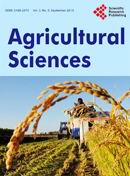Ver ítem
- xmlui.general.dspace_homeCentros Regionales y EEAsCentro Regional Santa FeEEA RafaelaArtículos científicosxmlui.ArtifactBrowser.ItemViewer.trail
- Inicio
- Centros Regionales y EEAs
- Centro Regional Santa Fe
- EEA Rafaela
- Artículos científicos
- Ver ítem
Productive Response of Dairy Cows Fed with Different Levels of Totally Mixed Ration and Pasture
Resumen
Forty multiparous Holstein cows in early lactation (66 ± 19 days) were assigned to one of four treatments that consisted in different ratios of total mixed rations (TMR) and pasture at 100% TMR (T0), 75:25 (T1) 50:50 (T2) and 25:75 (T3) over 9 weeks in autumn-winter. Measures of rumen parameters and digestion were performed on 4 additional Holstein cows in late lactation (287 days postpartum) fitted with permanent ruminal fistulae and producing 22.6
[ver mas...]
Forty multiparous Holstein cows in early lactation (66 ± 19 days) were assigned to one of four treatments that consisted in different ratios of total mixed rations (TMR) and pasture at 100% TMR (T0), 75:25 (T1) 50:50 (T2) and 25:75 (T3) over 9 weeks in autumn-winter. Measures of rumen parameters and digestion were performed on 4 additional Holstein cows in late lactation (287 days postpartum) fitted with permanent ruminal fistulae and producing 22.6 (±5.4) kg milk in a 4 × 4 Latin Square design. In T1 to T3 cows were taken to the grazing plot once they finished the pre-planned TMR intake and pasture was offered at 2 times the expected forage DM intake. Milk was analyzed for chemical composition, milk fatty acid (FA) profile and antioxidant compounds. The cows were individually weighed and body condition score (BCS) was determined. After the morning milking, blood samples were taken every 2 weeks and plasma was analyzed for glucose, urea, non-esterified fatty acids (NEFA), insulin, growth hormone (GH) and insulin-like growth factor (IGF-I). Herbage mass in pre grazing strips of pasture averaged 2540 ± 343 kg DM/ha. As TMR intake increased, production variables increased linearly excepting milk fat (3.88 g/100g) and milk protein (3.43 g/100g) contents that were not affected. Milk yield (kg/cow/d) resulted maximal in T0 (34.2) and linearly decreased (p < 0.01) with pasture intake averaging 32.1 (T1), 28.4 (T2) and 26.8 (T3) as a higher energy intake and a lower energy cost associated with grazing activity. Milk fat output (kg/cow/d) resulted higher in T0 (1.35) and T1 (1.25) compared to T2 (1.10) and T3 (1.04). Milk protein yield (kg/cow/d) was also higher in T0 (1.18) and T1 (1.11) compared to T2 (0.96) and T3 (0.92). Total DM (24.09 kg/cow/d) and energy (41.95 Mcal NEL/cow/d)) intakes resulted maximal in T0 decreasing as pasture replaced TMR without effects on conversion efficiency (1.48 kg milk/kg DM). Plasma concentration of glucose, insulin and IGF-I were not affected but GH and NEFA increased as pasture replaced TMR in T3. Ruminal pH (5.91) and total or VFA proportions did not differ but NH3-N concentration resulted higher in treatments with higher proportion of pasture. Kinetic parameters of DM and NDF digestion from pasture or corn silage were not affected. Milk FA profile and milk antioxidant quality showed unfavorably changes as TMR increased by a decrease in rumenic and linolenic acids and content of antioxidant vitamins, without effect on the atherogenicity index. Results suggested a depressing effect of the pasture on total DM and energy intake probably explained by qualitative deficiencies chemical composition of the forage and/or factors that affect animal behavior that may induce losses in body condition of high yielding dairy cows.
[Cerrar]

Fuente
Agricultural Sciences 9 (7) : 824-851 (July 2018)
Fecha
2018-07
ISSN
2156-8553
2156-8561
2156-8561
Formato
pdf
Tipo de documento
artículo
Palabras Claves
Derechos de acceso
Abierto
 Excepto donde se diga explicitamente, este item se publica bajo la siguiente descripción: Creative Commons Attribution-NonCommercial-ShareAlike 2.5 Unported (CC BY-NC-SA 2.5)
Excepto donde se diga explicitamente, este item se publica bajo la siguiente descripción: Creative Commons Attribution-NonCommercial-ShareAlike 2.5 Unported (CC BY-NC-SA 2.5)


